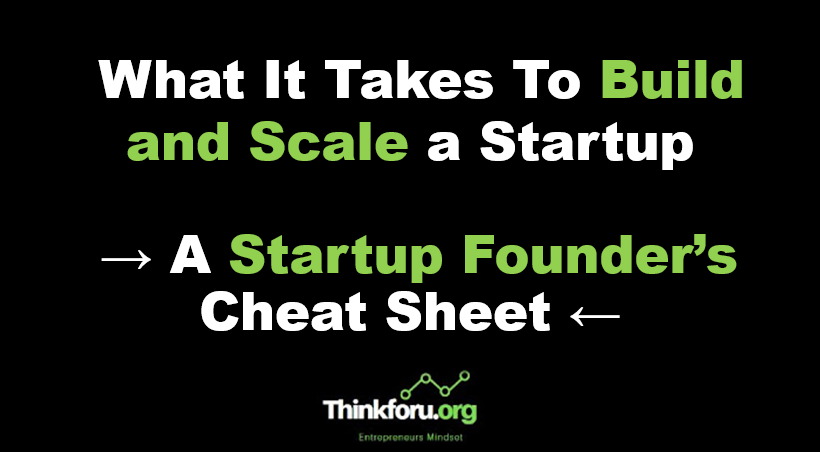What It Takes To Build and Scale a Startup → A Startup Founder’s Cheat Sheet ←
What It Takes To Build and Scale a Startup
→ A Startup Founder’s Cheat Sheet ←
 |
| Cover Image of What It Takes To Build and Scale a Startup → A Startup Founder’s Cheat Sheet ← |
Morgan Brown, one of growth’s OG’s, served as the Head of Growth at a number of high-growth startups.
He shared 5 key stages in a startup’s growth trajectory.
1. 𝐏𝐫𝐨𝐛𝐥𝐞𝐦/𝐒𝐨𝐥𝐮𝐭𝐢𝐨𝐧 𝐅𝐢𝐭
This is the stage where founders do heavy market research and talk to target users, asking them questions in an attempt to find their pain points. I recommend you bootstrap your efforts here before you even think about talking to an investor.
2. 𝐌𝐢𝐧𝐢𝐦𝐮𝐦 𝐕𝐢𝐚𝐛𝐥𝐞 𝐏𝐫𝐨𝐝𝐮𝐜𝐭 (𝐌𝐕𝐏)
This is the stage to prove demand and test customer behavior. Once your MVP is released, find initial users and see whether they remain with the product or abandon it. Your key metrics will simply be # of customers and $ per customer. If you have a good story to tell, you have a chance to get a pre-seed investment.
3. 𝐏𝐫𝐨𝐝𝐮𝐜𝐭/𝐌𝐚𝐫𝐤𝐞𝐭 𝐅𝐢𝐭
This is the stage where founders measure retention rates while surveying users to see how they feel about the product. The channels that are providing users should also be experimented with and explored. Great traction numbers here will get you a solid seed investment.
4. 𝐒𝐜𝐚𝐥𝐞
This is where you double down on the channels that work. Grow your team with experts and tools to support them. Create a playbook (the processes that define and grow the company) to optimize for growth and profitability. Getting major investors in Series A or B will tremendously boost your startup at this stage.
5. 𝐌𝐚𝐭𝐮𝐫𝐢𝐭𝐲
As the company matures, growth slows, but it doesn't stop. New channels, mergers, or acquisitions should be discovered. Pockets of new possible users should be approached. At this stage, you can expand globally and/or consider an IPO.
Of course, no two startup journeys are the same.
But every startup (including yours) will go through these key stages.
The Startup Lifecycle below is a great way to map out your trajectory.
As a startup founder, there are numerous tasks, decisions, and challenges you'll face on a daily basis. To help you navigate through this journey, here's a cheat sheet containing essential tips and advice for startup founders:
1. Start with a problem: Identify a genuine problem or pain point that your product or service can solve. Focus on providing value and creating a solution that people need.
2. Build a strong team: Surround yourself with talented individuals who complement your skills and share your vision. Hire people who are passionate, adaptable, and dedicated to the startup's success.
3. Define your mission and vision: Clearly articulate your startup's mission and long-term vision. This will guide your decision-making process and help align your team towards a common goal.
4. Know your target market: Conduct thorough market research to understand your target audience, their needs, and their preferences. This knowledge will inform your product development, marketing strategies, and customer acquisition efforts.
5. Minimum Viable Product (MVP): Develop an MVP that addresses the core problem and demonstrates your product's value proposition. Focus on essential features and functionalities to launch quickly and gather user feedback.
6. Iterate and pivot: Be open to feedback and willing to iterate on your product or business model. If the market demands it, don't hesitate to pivot and adjust your strategy accordingly.
7. Focus on customer acquisition: Develop a customer acquisition strategy to attract early adopters and build a user base. Leverage various marketing channels, such as social media, content marketing, partnerships, and referrals.
8. Embrace data-driven decision-making: Utilize analytics and data to gain insights into user behavior, measure key metrics, and make informed decisions. Collect and analyze relevant data to optimize your product and marketing strategies.
9. Secure funding: Explore different funding options, such as bootstrapping, angel investors, venture capital, crowdfunding, or government grants. Develop a compelling pitch deck and business plan to attract potential investors.
10. Network and seek mentorship: Attend industry events, join startup communities, and connect with experienced entrepreneurs. Seek mentorship from individuals who have successfully navigated the startup landscape and can provide valuable guidance.
11. Emphasize agility and adaptability: Startups operate in a dynamic and rapidly changing environment. Be agile, adaptable, and willing to pivot when necessary. Learn from failures and continuously iterate to improve your product and strategy.
12. Prioritize time management: As a founder, time is a valuable resource. Prioritize tasks, delegate effectively, and focus on high-impact activities that drive the growth of your startup.
13. Develop a strong company culture: Foster a positive and inclusive company culture that aligns with your values. Encourage open communication, collaboration, and a growth mindset within your team.
14. Monitor cash flow: Keep a close eye on your startup's finances and manage cash flow effectively. Maintain a budget, track expenses, and make strategic financial decisions to ensure sustainability and growth.
15. Seek feedback and listen to customers: Actively engage with your customers, listen to their feedback, and make improvements based on their needs. This will help you build a loyal user base and iterate your product effectively.
Remember, building a startup is a challenging but rewarding journey. Stay persistent, remain adaptable, and keep learning from both successes and failures. Good luck!